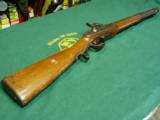
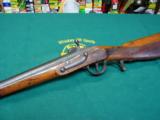
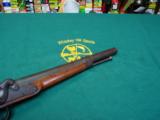
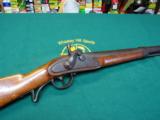
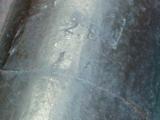
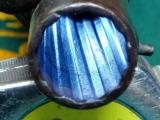
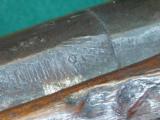
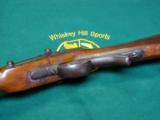

Kammer-Karabiner (chamber carbine) AUSTRIAN "LAP-GUN"
Guns International #: 100402004 Seller's Inventory #:
Category: Antique Rifles - Percussion - Civil War Rifles
Seller's Information
When emailing or calling sellers direct, please mention that you saw their listing on GunsInternational.com
Seller: BOPESTER
Company: WHISKEY HILL SPORTS
Member Since: 8/29/10
First Name: ROGER
State: Massachusetts
Country: United States
Phone: (413) 436-5885
Number of Active Listings: 7
Total Number of Listings: 457
Seller: FFL Dealer
Return Policy: 3 day inspection and return policy on used guns.
3 DAY
Payment Types Accepted: C/C,BANK CHEQUES,P.M.O.
Description:
!! REDUCED!! THIS GUN CAME FROM THE QUABBIN RESEVOIR HOMESTEADS.VERRY EARLY .CIVIL WAR ERA. USED IN THE CIVIL WAR BY BOTH SIDES?Austrian M-1851 Kammer-Karabiner (chamber carbine) (for years misidentified by collectors and scholars as the M-1842 cavalry carbine) was imported by both sides during the war, even though conventional wisdom has long identified these guns as having only been purchased by US buyers . The carbines were originally produced in Austria with the Augustin Consol Lock ignition system, better known to collectors as the “tube-lock” or “pill-lock” system. The guns also utilized a Delvigne chamber, better known by the French term “a-Tige”, in which a projection from the face of the breech upset the bullet, helping to make sure that it engaged the rifling, when the bullet was rammed home. The guns were short (only 30” in overall length), sturdy arms, manufactured with a beech stock that included a typical Austrian raised cheekrest, and an iron skeletonized pistol grip to the rear of the triggerguard. The barrel was only 14.5” in length, with a .71 caliber bore that was rifled with 12 deep, narrow grooves. When the Civil War began, arms purchasers and speculators scoured England and Europe for small arms that were available to purchase. These obsolete, ungainly carbines were quickly offered for sale by the Austrian government. The US government purchased at least 10,000 of these carbines, with that number obtained by US purchasing agent George Schuyler. These are the guns that are well documented as being issued to General Fremont’s western forces in early 1862. More recent scholarship has provided evidence that the Confederacy also purchased some of these carbines, and a handful of identifiable Confederate examples have been recently located. It appears that the majority of the carbines were altered to percussion prior to their importation to the US, most likely in Belgium, with some possibly altered in Austria or one of the Germanic states. Many of these carbines were additionally modified by the addition of a ramrod and a ramrod channel in the stock. It is presumed that in most instances these alterations were performed at the same time, although in some cases the ramrod modification might have happened after the percussion alteration. This additional alteration was necessary, as the Austrian cavalry carried their rammers separately from the carbines. Two primary percussion conversion systems have been identified and have been categorized as “Type I” and “Type II”. The “Type I” has a very “German” style bolster brazed to the original Augustin touch hole, and the “Type II” is the classic “Belgian” style with a built up cone seat and cone applied directly to the top of the breech. For more information on these interesting Austrian carbines, I recommend the recently published article in North-South Trader’s Civil War – Volume 35, No 4 – 2011 entitled The Austrian M-1851 Carbine REASONABLE OFFERS ARE ENCOURAGED..OR PLEASE CALL WITH QUESTIONS
SOLD
Antique: Yes